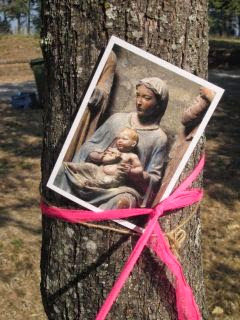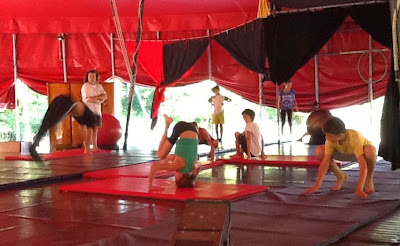I met Mariette Oudon while we were both sorting through a mound of enameled holy medals at a stall in the market in Malucene. She complimented my choice, the Virgin Mary on a pale green background, which made her look rather more like a Hindu goddess than the Mother of Jesus. We chatted a bit about holy medals, lighting candles and she urged me to go to the Abbaye, adding, with very sparkling eyes, that they bake the best bread in all of France. We paid for our medals and said a reluctant goodbye. As I stepped away she called out that she would remember me in her prayers.
Abbaye de Sainte Madeleine
Crickets and lavender and me.
The car park was "landscaped" like a Californian country club except that it was natural and there were no Mercedes or BMWs. There was only me, Louise and a flock of bees huddling around a dripping tap.
The church was absolutely still. I sat and listened to the blood course through my body and perhaps an hour passed. An older couple opened the north door and the sharp yellow light cut across the floor, the pews and my cheek, blinding me in one eye. I squinted to see their silhouettes: a broad bellied man with thin arms and a tiny woman with close cropped curls. They stood outside looking in, discussing something at length in loud breathy whispers. Their shoes scraped on the gravel underfoot and they let go of the door, returning me to the darkened silence.
Despite the tranquility and timelessness, the monastery is surprisingly new.
Around 1970 a Benedictine monk pooteled up to the small church of St. Madeleine on his moped
and was given permission to stay and live a monk's life. A couple days later a young and determined postulant appeared, and within a few months he joined the monk in his programme of prayer and thus the 'community' had begun.
Within a year, their numbers had grown to eleven monks and they started to restore a small ruined priory which they quickly outgrew.
On the 21st of March 1980 they laid the
foundation stone on which is engraved the motto of the monastery : Pax
in Lumine (Peace in Light). This describes the mission of the monks: "to
bring down a little of the peace of heaven." By 2002 there were sixty monks living a cloistered and prayerful existence in this little bit of heaven in the Vaucluse.
According to Benedictine Rule they devote their life to prayer, study and manual labour. Between their prayers, (seven times a day starting at 3:30 am on weekdays and nine times on Sundays) they bake the best bread in France, mill flour, tend vineyards and make wine, build, grow vegetables, keep bees etc.etc etc.
Four times a year the monks go walk about.
I wrote about this already in the August 1st posting.
The monastery can be Googled and youtubed. Moreover, one can download their services,
sung in Gregorian chant, in real time on the computer or via an app on one's mobile!
My utterly naive and hand flapping amazement seems to indicate that I,
Ms. Terribly Modern Cosmopolitan Woman, am a total luddite
while these cloistered men are the ones who are digitally savvy.
http://www.youtube.com/watch?v=tYRhbvKsCl8
from their website- http://www.barroux.org/
“There is only one problem
in the whole world: restoring spiritual sense in people. Shower on
them something like a Gregorian chant. ”
Antoine de Saint-Exupéry
























